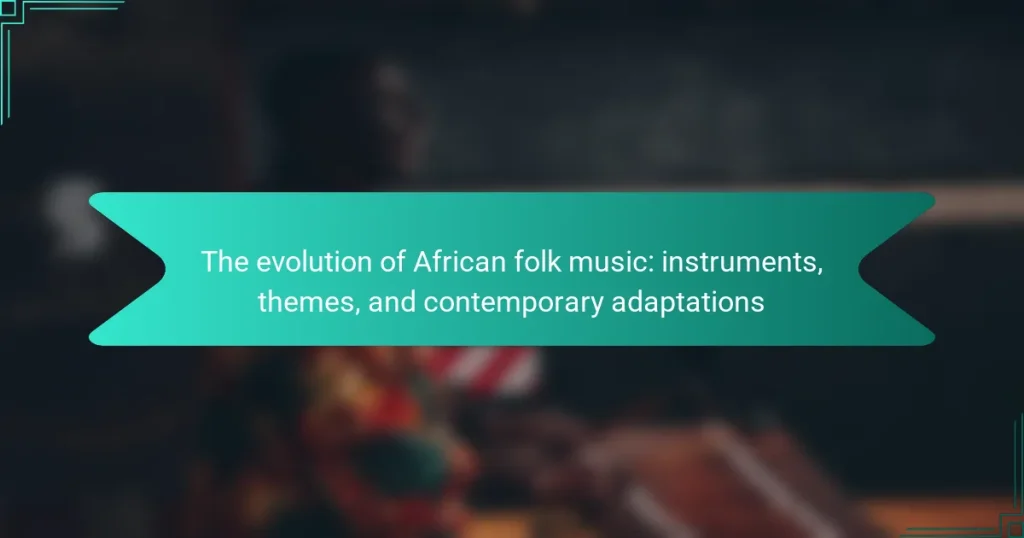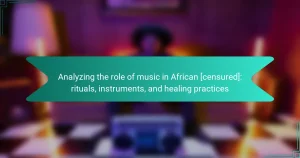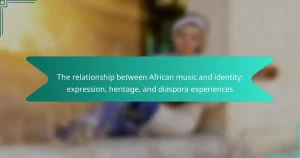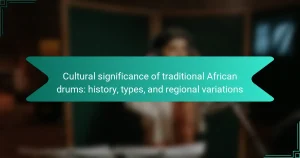African folk music is a rich cultural expression that has evolved over centuries, rooted in ancient traditions of oral storytelling and communal participation. Key instruments such as the djembe, kora, and mbira have played significant roles in this musical heritage, reflecting daily life, spiritual beliefs, and social events. The music has undergone transformations during the colonial period and post-independence, incorporating European influences and emerging as a symbol of cultural identity. Contemporary adaptations feature modern instrumentation and fusion genres, blending traditional rhythms with styles like jazz, hip-hop, and reggae, while collaborations between African and international artists further enhance its global reach. This article explores the evolution of African folk music, highlighting its instruments, themes, and modern interpretations.
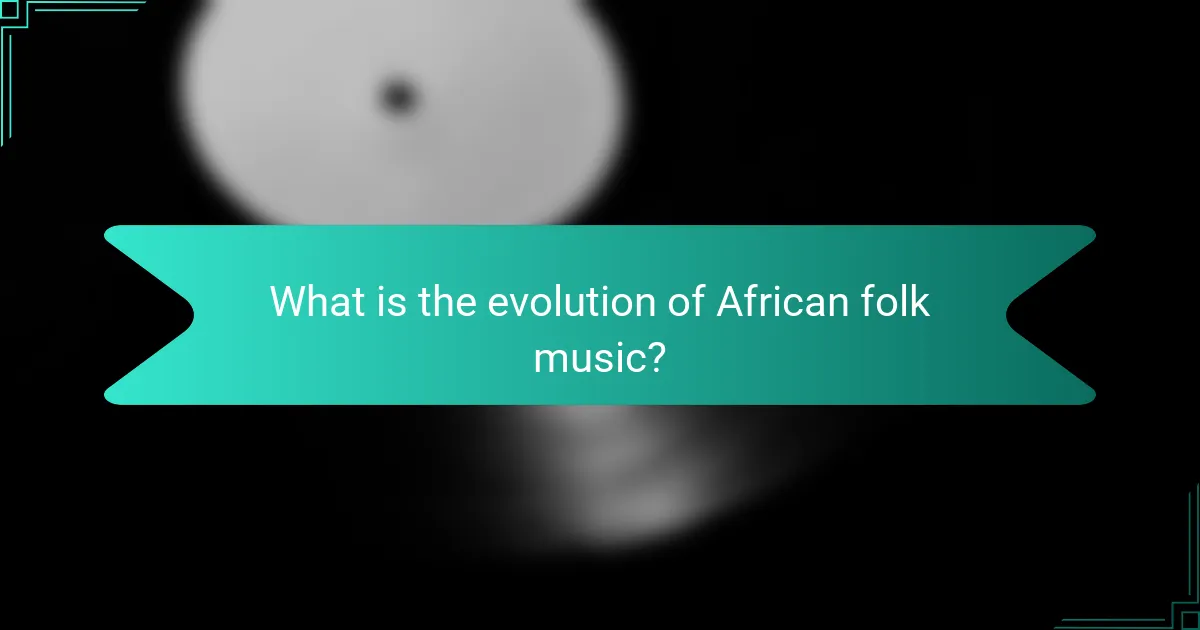
What is the evolution of African folk music?
African folk music has evolved significantly over centuries. Its roots trace back to ancient traditions that involved oral storytelling and communal participation. Instruments such as drums, mbira, and kora were central to these early forms. The music often reflected daily life, spiritual beliefs, and social events.
During the colonial period, African folk music absorbed influences from European styles. This fusion led to the emergence of new genres, blending traditional rhythms with foreign melodies. Post-independence, African nations embraced folk music as a symbol of cultural identity.
Contemporary adaptations have introduced modern instruments and technology. Artists now incorporate elements from genres like jazz, hip-hop, and reggae. This evolution continues to highlight the rich diversity and resilience of African cultural heritage.
How has African folk music changed over time?
African folk music has evolved significantly over time. Traditional forms have incorporated various cultural influences. The introduction of Western instruments has altered sound and style. Themes have expanded to include contemporary social issues. Globalization has facilitated cross-cultural collaborations. Modern technology has increased accessibility and distribution. These changes reflect both preservation and innovation in African music. Historical shifts, such as colonialism, also impacted musical expression and identity.
What historical events influenced the evolution of African folk music?
Colonialism significantly influenced the evolution of African folk music. European colonization disrupted traditional societies and introduced new musical forms. The transatlantic slave trade forced many Africans to adapt their music in unfamiliar environments. This led to the fusion of African rhythms with European styles, creating new genres. The struggle for independence in various African nations also inspired folk music themes. These events shaped the identity and cultural expression within African communities. Historical movements, such as the civil rights movement, further influenced African music globally. Each of these events contributed to the rich tapestry of African folk music as we know it today.
How have cultural exchanges impacted African folk music?
Cultural exchanges have significantly enriched African folk music. These exchanges have introduced new instruments, styles, and themes. For instance, the arrival of European musical instruments like the guitar has influenced traditional African sounds. Additionally, interactions with African diaspora communities have led to the fusion of genres. This is evident in the blending of African rhythms with jazz and blues.
The impact of cultural exchanges can be seen in contemporary African artists. Many now incorporate global music trends into their work. This has resulted in the evolution of African folk music, making it more diverse. Research shows that these influences have helped preserve folk traditions while also modernizing them. Thus, cultural exchanges continue to shape the landscape of African folk music.
What are the key characteristics of traditional African folk music?
Traditional African folk music is characterized by its use of oral traditions, rhythmic complexity, and community involvement. Oral traditions ensure stories and cultural heritage are passed down through generations. Rhythmic complexity often involves polyrhythms, which create intricate sound patterns. Community involvement is essential, with music typically performed during social events, rituals, and ceremonies. Instruments such as drums, mbiras, and kora are commonly used, showcasing regional diversity. Lyrics often address themes of life, nature, and social issues, reflecting the community’s values and experiences. The music serves both entertainment and educational purposes, reinforcing social cohesion.
What instruments are commonly used in African folk music?
Common instruments used in African folk music include the djembe, kora, mbira, and balafon. The djembe is a hand drum originating from West Africa, known for its deep bass and high tones. The kora, a 21-string lute, is prevalent in West African countries and is played by griots. The mbira, also known as the thumb piano, is used in various regions, especially in Zimbabwe, and produces a soothing sound. The balafon, a wooden percussion instrument, is similar to a xylophone and is common in West African music. These instruments reflect the rich cultural heritage and diverse musical traditions across the continent.
What themes are prevalent in African folk music?
Prevalent themes in African folk music include community, storytelling, [censured], and nature. Community themes emphasize social cohesion and collective identity. Storytelling often conveys history, lessons, and cultural values. [censured] reflects beliefs, rituals, and connections to ancestors. Nature themes celebrate the environment and its relationship with humanity. These themes are rooted in African cultural practices and oral traditions. They serve to educate, entertain, and preserve heritage across generations.
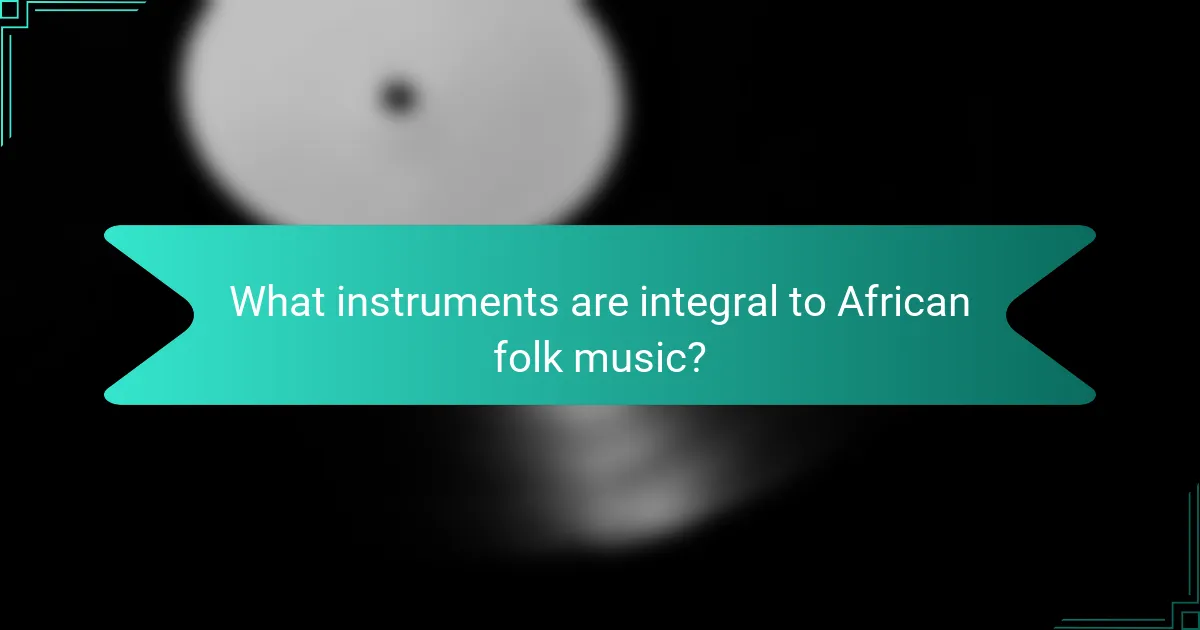
What instruments are integral to African folk music?
Integral instruments in African folk music include the djembe, kora, and mbira. The djembe is a hand drum originating from West Africa. It is known for its wide range of tones and is used in various ceremonies. The kora is a string instrument made from a gourd and has 21 strings. It is played primarily in West African countries and is significant in storytelling traditions. The mbira, also known as the thumb piano, features metal tines and is essential in Southern African cultures. These instruments are often used in communal gatherings and rituals. Their roles reflect the cultural heritage and social functions of African communities.
How do different regions contribute unique instruments?
Different regions contribute unique instruments through their distinct cultural practices and traditions. For example, West Africa is known for the djembe, a hand drum with deep roots in community rituals. The djembe’s construction varies by region, reflecting local materials and craftsmanship. In East Africa, the kora, a stringed instrument, combines elements from both African and Islamic musical traditions. Each region’s historical context influences the design and use of these instruments. Southern Africa introduces the mbira, or thumb piano, which is integral to spiritual ceremonies. These instruments not only serve musical purposes but also embody the cultural identity of their respective regions. Each region’s unique contributions enrich the diversity of African folk music.
What are some examples of traditional instruments from West Africa?
Some examples of traditional instruments from West Africa include the djembe, kora, and balafon. The djembe is a goblet-shaped drum made from wood and animal skin. It is played with bare hands and produces a wide range of tones. The kora is a stringed instrument resembling a harp. It has 21 strings and is often used in storytelling and music. The balafon is a wooden percussion instrument similar to a xylophone. It consists of wooden bars and gourd resonators. These instruments are integral to the region’s cultural heritage and musical traditions.
What instruments are specific to East African folk music?
Specific instruments in East African folk music include the mbira, the adungu, and the nyatiti. The mbira is a thumb piano traditionally used in Zimbabwe and parts of East Africa. The adungu is a large, curved harp primarily played in Uganda. The nyatiti is a seven-stringed lyre from the Luo community in Kenya. These instruments are integral to cultural ceremonies and storytelling. Each instrument has a distinct sound and playing technique that reflects the region’s musical heritage. Their use in folk music highlights the rich diversity of East African traditions.
What role do instruments play in the storytelling aspect of African folk music?
Instruments are crucial in the storytelling aspect of African folk music. They provide a rhythmic and melodic foundation that enhances narratives. Each instrument carries cultural significance and conveys emotions. For example, the kora, a string instrument, often accompanies tales of heroism and love. Drums, such as the djembe, punctuate stories with beats that reflect the mood. The use of call-and-response patterns engages the audience, making them part of the story. Instruments also help preserve oral traditions by embedding stories within music. This integration of sound and narrative creates a rich, immersive experience for listeners.
How do instruments enhance the emotional expression in folk songs?
Instruments enhance the emotional expression in folk songs by adding depth and texture to the music. They provide a range of sounds that evoke different feelings. For example, string instruments like the kora can create soothing melodies. Percussion instruments, such as drums, can convey urgency and excitement. The choice of instrument influences the mood of the song. Specific techniques, like strumming or drumming patterns, can intensify emotions. Additionally, instruments often carry cultural significance, connecting listeners to their heritage. This connection can amplify the emotional impact of the lyrics. Overall, instruments serve as a vital tool for expressing complex emotions in folk music.
What are the techniques used to play these instruments?
The techniques used to play African folk instruments vary widely. Instruments such as the djembe utilize hand techniques for striking. Players often use different hand positions to create a range of tones. The kora, a stringed instrument, employs finger plucking techniques. Musicians use both thumbs and forefingers to produce melodies. The mbira, or thumb piano, is played by plucking metal tines with the thumbs. This creates a resonant sound that is characteristic of its music. Techniques also include rhythmic patterns that are culturally specific. Improvisation is a common practice, allowing musicians to express individuality. These techniques have evolved while retaining traditional elements, showcasing the rich heritage of African folk music.
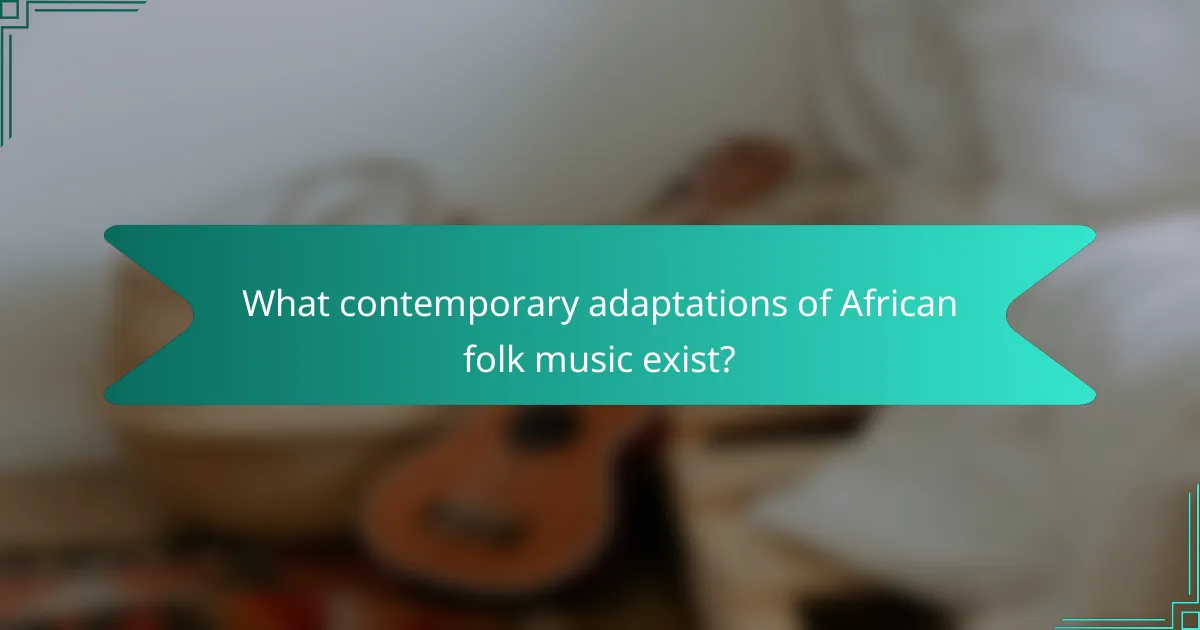
What contemporary adaptations of African folk music exist?
Contemporary adaptations of African folk music include fusion genres, modern instrumentation, and global collaborations. Artists blend traditional rhythms with contemporary styles like jazz, hip-hop, and electronic music. For instance, the South African group Freshlyground combines folk elements with pop and jazz influences. Nigerian artist Burna Boy incorporates Afrobeat with traditional sounds in his music. Additionally, musicians often use modern instruments alongside traditional ones, enhancing the sound. Collaborations between African artists and international musicians further expand the reach and reinterpretation of folk music. These adaptations reflect cultural evolution and global influence while preserving traditional roots.
How have modern artists incorporated traditional elements into their music?
Modern artists have incorporated traditional elements into their music by blending folk instruments and rhythms with contemporary styles. They often use instruments like the kora or djembe alongside electronic music. This fusion creates a unique sound that honors cultural heritage while appealing to modern audiences. For example, artists like Baaba Maal and Angelique Kidjo integrate traditional melodies with pop and world music influences. Their works often reflect themes of identity and community, rooted in African traditions. This approach not only preserves cultural elements but also introduces them to new listeners globally. The result is a vibrant and evolving music scene that respects its origins while innovating for the future.
What genres blend African folk music with contemporary styles?
Genres that blend African folk music with contemporary styles include Afrobeat, Afrofusion, and World Music. Afrobeat combines traditional African rhythms with jazz and funk elements. Afrofusion merges various genres like hip-hop, reggae, and R&B with African musical traditions. World Music encompasses diverse global influences, integrating African folk sounds into broader contemporary contexts. These genres reflect the dynamic evolution of African music, showcasing its adaptability and global appeal.
Who are some notable contemporary African folk musicians?
Notable contemporary African folk musicians include Salif Keita, Vusi Mahlasela, and Angélique Kidjo. Salif Keita, from Mali, is known for blending traditional African music with pop influences. Vusi Mahlasela, a South African artist, incorporates his folk roots into powerful political messages. Angélique Kidjo, also from Benin, combines African music with various genres, earning international acclaim. These musicians exemplify the evolution of African folk music through their unique styles and global reach. Their contributions highlight the rich cultural heritage and contemporary adaptations of African folk traditions.
What impact does globalization have on African folk music?
Globalization has significantly influenced African folk music. It has facilitated the fusion of traditional sounds with global music genres. This blending has led to the creation of new musical styles. Artists now incorporate elements from hip-hop, jazz, and pop into their folk music. Increased access to technology has allowed for wider distribution of African folk music. Streaming platforms enable artists to reach international audiences. Cultural exchange has also introduced new themes and lyrical content. However, globalization can threaten the authenticity of traditional forms. Preservation efforts are crucial to maintain the integrity of African folk music.
How does technology influence the preservation of traditional music?
Technology significantly influences the preservation of traditional music by enabling easier documentation and sharing. Digital recording tools capture live performances, ensuring that unique sounds are not lost. Online platforms allow for global distribution, reaching wider audiences. Social media facilitates community engagement, fostering interest in traditional music forms. Additionally, software programs help in archiving and analyzing music, preserving cultural heritage. Research indicates that these technologies can revitalize interest in traditional music among younger generations. For instance, the use of apps for learning traditional instruments has increased participation rates. Overall, technology acts as a bridge connecting past traditions with contemporary practices.
What challenges do contemporary artists face in maintaining authenticity?
Contemporary artists face significant challenges in maintaining authenticity. Market pressures often compel artists to conform to popular trends. This can dilute their unique artistic voice. Additionally, the commercialization of art can lead to a focus on profit over genuine expression. The influence of social media creates expectations for constant engagement, which can distract from the creative process. Artists also navigate cultural appropriation concerns, where their work may be misunderstood or misrepresented. These factors collectively complicate the pursuit of authentic artistic expression.
What are some practical ways to engage with African folk music today?
Attend live performances of African folk music to experience its cultural richness firsthand. Many cities host festivals celebrating African music. Participate in workshops that teach traditional instruments, such as the djembe or kora. These workshops often provide hands-on experience with the music. Listen to recordings or streaming playlists dedicated to African folk music. This exposes listeners to various regional styles and rhythms. Explore online platforms that offer courses on African music theory and composition. These resources help deepen understanding of the music’s structure. Collaborate with local musicians to create fusion projects combining African folk music with other genres. This encourages cultural exchange and innovation. Engage with community organizations that promote African music and culture. They often organize events and educational programs.
How can one learn to play traditional African instruments?
One can learn to play traditional African instruments through various methods. Enrolling in music classes focused on African music is beneficial. Many cultural centers and music schools offer specialized courses. Finding a local teacher with expertise in traditional instruments is also effective. Online tutorials and video lessons provide accessible learning options. Participating in workshops or community events fosters hands-on experience. Engaging with local musicians enhances practical skills and cultural understanding. Listening to recordings of traditional music aids in developing an ear for rhythm and style.
What resources are available for exploring African folk music themes?
Resources for exploring African folk music themes include academic journals, books, and online databases. Notable journals such as “African Music” and “Ethnomusicology” publish research on African music traditions. Books like “The Music of Africa” by J. H. Kwabena Nketia provide in-depth analysis and context. Online platforms such as JSTOR and Google Scholar offer access to scholarly articles and papers. Additionally, music archives like the International Library of African Music house recordings and research materials. Documentaries and ethnographic films also serve as valuable resources, showcasing performances and cultural contexts. These resources collectively enhance understanding of African folk music themes.
The main entity of the article is African folk music, which has undergone significant evolution over centuries, influenced by historical events and cultural exchanges. The article explores the roots of African folk music, key instruments, prevalent themes, and the impact of globalization and technology on its contemporary adaptations. It highlights how traditional elements are preserved while integrating modern styles, showcasing notable contemporary musicians and their contributions. Additionally, the article emphasizes the importance of community involvement and the role of instruments in storytelling, reflecting the rich cultural heritage of Africa.
